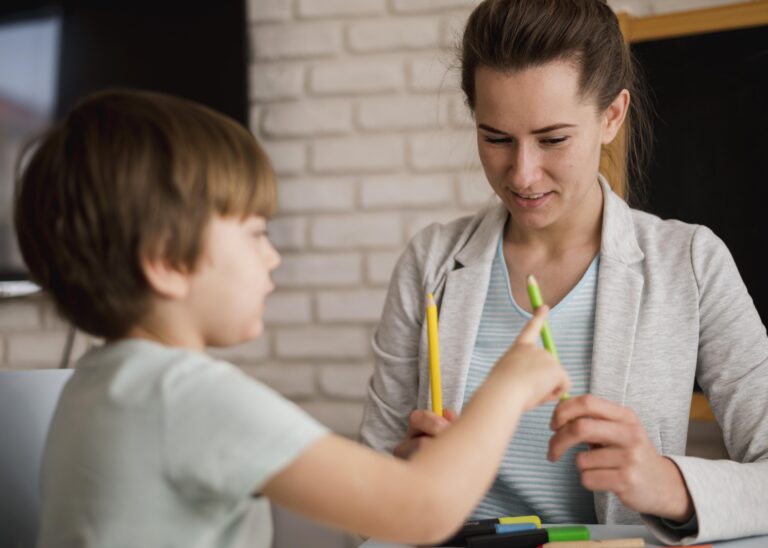Preparing for the New School Year
Essential Strategies for a Sensory-Friendly School Year
For children with a neurological disorder, bustling hallways, and cluttered classrooms can exacerbate stress, detracting from their learning experience. Specialized strategies that hone in on sensory processing can transform the school environment, offering a more tailored approach that feels both welcoming and conducive to education. Incorporating elements of therapy into daily routines can significantly alleviate discomfort and aid academic success. In this article, we lay out effective methods to ensure that each day at school is a sensory-friendly journey that supports learning and growth. Keep reading to equip yourself with these essential tactics for a more inclusive educational atmosphere.
Key Takeaways
- Sensory-Friendly Classroom Design Is Critical for Diverse Learning Needs
- Predictable Schedules and Visual Aids Can Reduce Student Anxiety
- Mindfulness and Self-Regulation Techniques Foster a Calm Learning Environment
- Flexibility in Assignment Submission Accommodates Individual Student Strengths
- Access to Sensory Tools and Materials Supports Focused Learning
Classroom Planning, Schedules, and Routines
As you press ahead with the academic year, recent evidence underscores the need for a meticulously planned classroom environment, one that tastefully caters to diverse sensory needs. A pronounced understanding of each student’s unique sensory profile, perhaps shaped by a diagnosis or insights accrued from sensory integration therapy, fuels the daily dynamic of your classroom design. Let’s look at fine-tuning the physical space to address those needs, creating a reassuring rhythm with schedules that students can rely upon, and embedding the necessary pauses for sensory regulation. Moreover, visual aids stand out as a vital tool in fostering clear and effective communication, and the adoption of quiet zones offers a sanctuary for those grappling with sensory overload. Each of these strategies represents a thread in the tapestry of a sensory-friendly classroom that aligns with the individual needs of your pupils, ensuring their educational experience is accommodative and enriching.
Tailoring Classroom Layout for Sensory Needs
Your commitment to every student, including those with a disability, begins with an intentional design of the classroom space. Acknowledge the signs and symptoms unique to each individual, and modify your classroom layout to bolster their learning and social capabilities, seamlessly integrating neurodiversity into your educational plan.
For students navigating the challenges of a learning disability, classroom design can significantly influence their ability to thrive. Strategically place workstations and seating to minimize distractions, and create areas that enhance focus and social skills, ensuring that each child has access to a supportive learning environment.
Establishing Predictable Schedules for Students
A sensory-friendly schedule acts as your roadmap, guiding each student through the intricacies of their school day with predictable transitions that can significantly decrease anxiety. If you have pupils who are particularly sensitive to sudden shifts in activity, consider punctuating their schedule with consistent computer time, an experience that often offers a calming, single-focus stimulus that’s easier to manage.
Incorporate the use of headphones into daily routines for students who might be overwhelmed by the cacophony of classroom sounds, as recommended by leading voices in the field of psychiatry. This simple adjustment in the scheduling of activities can make a profound difference in providing a sensory-friendly atmosphere that allows concentration to flourish without the intrusion of disruptive noise.
Incorporating Sensory Breaks Into the Daily Routine
Incorporating short, routine breaks for sensory regulation into the daily agenda can act as a buffer against sensory overload, much like a balanced diet sustains physical health. Tailor these pauses to offer students an opportunity to step back from stimuli like the incessant sound of voices or the almost imperceptible scrape of pencils, providing a haven where sensory input is managed and not overwhelming.
Consider the sensory input from clothing, an often overlooked aspect that may contribute to discomfort throughout the school day. By allotting time for students to adjust or change into more suitable attire, if necessary, during a scheduled break, you’ll facilitate an environment less prone to sensory overload, allowing focused learning without the distraction of tactile irritation.
Using Visual Aids for Better Communication
Your strides toward enhanced communication within the sensory-friendly classroom can be greatly bolstered by the incorporation of visual aids. Whether it’s a color-coded carpet signaling different zones or paper signs that delineate quiet areas, visuals help to bridge the gap in neurology between processing words and comprehending the environment, especially for students with sensory processing disorder.
In areas like the cafeteria where sensory stimuli converge, visual cues maintain clarity amidst potential chaos. Establishing this form of communication aids all students in navigating their surroundings more effectively, as clear signage translates into less guesswork and more confidence for those sensitive to their environment.
Implementing Quiet Zones for Overstimulated Students
Within your school community, creating an oasis of tranquility through quiet zones becomes pivotal for students who grapple with sensory overload. With guidance from occupational therapy practitioners, these specially tailored areas can be equipped with soothing elements such as subdued lighting or tactile objects like chewing gum, which can serve as a focal point for students needing to redirect their sensory input.
Designate a corner of your classroom as a designated haven, where students can retreat when the sensory demands of the day prove to be too taxing. This initiative not only assists in dampening the cacophony of classroom life but also respects the personal space of every pupil, allowing them the autonomy to monitor their sensory needs and seek respite for their eyes and minds, courtesy of the thoughtfully implemented strategies by educator Lee.
Building Self-Regulation Skills
As you steer your students through their education journey, the skill of self-regulation emerges as a cornerstone for managing sensory stimulation and emotional turmoil. Recent research furnishes compelling information that supports the integration of deep breathing and meditation techniques within the school curriculum, thus equipping young learners with invaluable tools for alleviating pain. The judicious use of sensory instruments can further scaffold this learning, as highlighted within an array of educational PDFs and resources. Embracing mindfulness as a collective endeavor enriches the class atmosphere, fostering a shared understanding of presence and focus. Moreover, you can empower each student by aiding them in crafting personalized strategies that resonate with their unique set of experiences and needs. These methods not only cultivate resilience but also imbue your students with an enhanced capacity for navigating the inevitable ebbs and flows of the school year.
Teaching Deep Breathing and Meditation Techniques
Deep breathing and meditation, as endorsed by occupational therapists, offer sanctuary from the storm of classroom stimuli that can trigger anxiety and hypersensitivity in students. These techniques encourage a modulation of behavior that supports coping in a sensory-rich environment, fostering a sense of calm and control that is paramount for academic success.
A systematic review of mindfulness practices in educational settings reveals that teaching such techniques can attenuate stress responses and improve concentration. By integrating these practices into your teaching, you equip students with strategies to self-regulate, enabling them to navigate their sensory experiences with greater ease and confidence.
Encouraging the Use of Sensory Tools
Your guidance in the appropriate use of sensory tools can vastly improve students’ concentration, both during demanding homework sessions and the stimulating environment of recess. Suggesting items such as noise-canceling ear muffs or textured fidgets can offer a tactile distraction, aiding the brain’s ability to process and prioritize sensory information effectively.
The introduction of sensory tools into the academic setting doesn’t merely quiet the mind; it potentially boosts the intelligence quotient by helping to filter out extraneous stimuli. This enables a sharper focus for brainwork demanded by complex tasks, supporting your student’s academic achievements and emotional well-being in tandem.
Practicing Mindfulness as a Class Activity
Integrating mindfulness exercises into class rituals might challenge the statistic-heavy pages of the Diagnostic and Statistical Manual of Mental Disorders, bypassing medication for moment-to-moment awareness. When you guide your learners through focused breathing or gentle stretches, akin to what might be found in a physical education class, you place them squarely in the pilot’s seat of their emotional and sensory experiences.
You can create a ripple effect of tranquility that extends beyond the physical confines of the chair they’re seated in, by incorporating quiet contemplation periods into the daily routine. The field of pediatrics consistently acknowledges the profound impact of stress reduction on childhood development, and through these shared mindfulness practices, you cultivate a classroom environment conducive to both personal growth and academic exploration.
Creating Personalized Coping Strategies
Collaborating with a psychologist, you can tailor coping strategies for students with spectrum disorder or attention deficit hyperactivity disorder, ensuring these strategies align with their individual sensory preferences. This personalization may include multisensory integration techniques that bolster focus during tasks that require sustained attention, such as handwriting.
As each student navigates the complexities of the learning environment, empower them with tools for self-regulation. Personal strategies may involve a sequence of sensory activities or self-directed breaks designed to recalibrate their sensory systems, reflecting an understanding of their unique responses to sensory stimuli.
Giving Instructions and Completing Assignments
Envision, for a moment, that you are creating a learning space where the filtering beams of sunlight cast the least restrictive environment possible. Here, each verbal directive you provide thrives with emotion and is as comforting as a soft hug, while every glance of eye contact illuminates a pathway for understanding. Crafting a framework for these interactions involves the use of visual guides to simplify instructions, embracing diverse submission formats for assignments, providing clear directions with stepwise clarity, and generously offering extra time for task completion. These measures are your proactive steps to reassure and bolster every student’s ability to navigate the curriculum, ensuring that assignments are not just tasks but lights guiding them toward success.
Simplifying Instructions With Visual Guides
The clarity with which you deliver instructions can significantly alter a student’s perception and capacity to complete tasks successfully. Introduce visual aids in the classroom—charts, diagrams, or even step-by-step cartoons; these not only minimize cognitive stimulation for overwhelmed minds but also ensure comprehension is accessible and serviceable to each learner, in line with the multifaceted language of senses that drive understanding.
As a teacher, leverage the power of visual guides to distill complex instructions into digestible visual snippets that resonate with every sense. This strategy not only aligns with your terms of service to deliver exceptional education but also respects the diverse learning spectrums of your students, ensuring that each child feels seen and supported in their educational journey.
Allowing Alternative Assignment Submission Formats
Embracing flexible submission formats takes into account the varying needs of students, particularly for those with sensory processing sensitivity or syndromes that affect attention. By providing the chance to submit assignments orally, through video presentations, or other creative avenues, you honor their learning space and validate their individual educational experiences.
Nurturing an inclusive environment where diverse sensory needs are respected allows students to demonstrate their understanding in a manner that aligns with their strengths. This approach to assignments recognizes that traditional paper-based submissions might not cater to every learner, ensuring that all students have equal opportunities to excel and showcase their achievements.
Providing Clear, Step-by-Step Directions
Guiding your students with clarity and precision through the murk of ambiguous tasks is a must; break down the steps of assignments into structured segments. Keep in mind that your pupils, particularly those with Asperger syndrome, may thrive on this form of organization, as it provides them with a roadmap for navigating tasks. Recognize their need for predictability and structure right down to their seating – a well-positioned desk can be a bastion of consistency, aiding proprioception and grounding their educational experience.
Presenting instructions as modular, bite-sized pieces ensures that students can absorb and process information without undue stress, a practice that can bolster mental health. This approach is akin to peeling back the layers of an ongoing project, revealing each successive step with patience and care; such clarity can improve overall student performance and may even contribute to better sleep, by minimizing the anxiety associated with complex assignments:
- Open your textbooks to the designated chapter and read the first two sections.
- Highlight key terms and concepts you find in your reading.
- At your desk, draft an outline based on your highlights, providing a clear structure for your upcoming essay.
- Review the draft with a partner, checking for comprehension and completeness from each other’s perspective.
- Revise the draft independently, incorporating feedback from your peer review session.
Offering Extra Time for Completion of Tasks
Recognizing that the rhythm of learning differs for every student, especially those under the care of physical therapy, affords them the grace of time to balance education with health needs. Allowing extra time for task completion respects their pacing, as some may need intervals to manipulate a stress ball for proprioceptive feedback or liaise with a caregiver for support. This accommodation fosters an equitable environment where students’ unique needs are met with understanding and kindness.
The integration of extra time can reduce the tension students feel when they rush through tasks, enabling a harmony akin to a well-composed piece of music. By extending deadlines, you give students the room to absorb information thoroughly, apply their knowledge with care, and attend to personal health routines without the added pressure of a ticking clock.
- Review the concept of physical therapy with students, discussing how it could intersect with their academic routines.
- Encourage students to bring a small ball to class, which can be used for hand exercises during extended work periods.
- Discuss with caregivers the best practices for incorporating extended time in a home study schedule, ensuring consistency and understanding.
- Introduce periods of music during extended assignment time to create a calming atmosphere conducive to focus and inspiration.
- Consistently remind students that their health is a priority and that the classroom is a space where their well-being is supported alongside academic growth.
More Resources
Arming yourself with an array of educational resources is a prudent step in nurturing a learning environment that attunes to the sensory nuances of each student. Curating a list of sensory-friendly materials that may include specialized cushions or sunglasses designed for visual comfort can offer a touchstone for students, especially those on the autism spectrum, seeking consistency in their tactile and visual experiences. Engaging with online forums connects you with a support network that provides fresh ideas and shared experiences, vital for adapting to each unique situation. By attending workshops focused on sensory processing, you sharpen your understanding of the auditory, tactile, and proprioceptive inputs that shape learning experiences. Lastly, subscribing to newsletters keeps you informed on the latest strategies and developments, ensuring your approach remains current and informed, all the while placing a special emphasis on hearing and respecting the individual sensory needs of your pupils.
Curating a List of Sensory-Friendly Materials
As a parent, you understand the profound impact that a well-matched sensory environment can have on your child’s nervous system, mood, and capacity for learning. Curating a selection of sensory-friendly materials, such as cushioned floor mats or noise-canceling headphones, can provide an atmosphere that nurtures creativity and academic exploration for those with sensory sensitivities.
Encourage your school’s educators to assemble a suite of resources that not only muffle unwelcome noise but also enhance the learning ambiance. Such an investment aids in stabilizing the fluctuating mood states tied to sensory overload, offering a reprieve for the nervous system and fostering a fertile ground for creativity and focus.
Accessing Online Forums for Support and Ideas
Nurturing a well-rounded educational experience for students often requires you to exercise a degree of creativity and resourcefulness. Accessing online forums connects you with a global community where sharing firsthand experiences with students who have conditions like schizophrenia can provide enlightening data and pave the way for innovative teaching methods.
These platforms, rooted in the collective wisdom of psychology professionals, educators, and families, empower you with an array of strategies backed by empirical evidence. Engage in these discussions to refine your classroom practices and gain deeper insights into creating sensory-friendly learning environments that support every student’s needs.
Attending Workshops on Sensory Processing Issues
Investing time in workshops focused on sensory processing issues can significantly enhance your educational toolkit, arming you with the latest methods and research findings. These sessions, often led by experts in neurology and child development, grant you the capacity to tailor classroom experiences that cater to a broad spectrum of sensory needs.
By attending specialized training, you gain the ability to recognize early signs of sensory processing challenges and respond with effective interventions. These workshops serve as a channel to acquire advanced skills that ensure all students, especially those with sensory sensitivities, are supported in an inclusive and nurturing school environment.
Subscribing to Newsletters for Latest Strategies
Keeping your instructional approach fresh and current is as simple as subscribing to specialized newsletters. With these regular updates, you remain at the forefront of educational strategies, especially those tailored for sensory integration.
Receive insights and fresh perspectives right to your inbox, transforming the latest trends in sensory-friendly education into actionable plans for your classroom. Consider these missives your direct line to ongoing professional development, a treasure of resources that educates and inspires:
- Subscribe to a trusted newsletter that focuses on sensory-friendly strategies and tools.
- Implement new ideas from the newsletter into your lesson plans and classroom setup.
- Share beneficial tips and resources with colleagues to promote a collective approach to sensory integration.
Share
As you navigate the school year, embracing collaboration and knowledge-sharing is a catalyst for success. Spot the opportunities to connect with fellow educators, channeling their experiences and strategies into your classroom practices. Take the initiative to organize awareness campaigns, sparking conversations on sensory-friendly environments school-wide, ensuring staff and students alike understand and support these vital practices. Extend your reach by directing parents to online resources, and enhancing their support network with tools and actionable insights. Sharing strengthens your educational community, weaving a collective tape fandom and student well-being.
Connecting With Other Educators
Building a sensory-friendly school environment is a shared journey. Engage actively with other educators in your school to exchange insights on accommodating diverse sensory needs. Your dialogues will mold a cohesive team aligned with the shared vision of providing an optimal learning space for all students.
These conversations can foster a rich exchange of tried-and-true methodologies and inspire new approaches. Recognize the value of your peers’ experiences as they bring forth an abundance of understanding from their own classrooms:
- Organize monthly meetings focused on sensory integration education and best practices.
- Invite guest speakers from various disciplines to offer broader perspectives and inform your collective strategy.
- Create a shared digital repository of resources such as articles, lesson plans, and sensory-friendly tools.
Organizing School-Wide Awareness Programs
Initiate a dialogue that spans the entire school community regarding the importance of sensory-friendly practices. Begin by setting up awareness programs that invite guest speakers specializing in sensory integration, arranging workshops, and hosting informative assemblies that demystify the concepts and illustrate the benefits for all students.
Cultivate a culture of empathy and inclusion by organizing interactive experiences, such as sensory walks or simulation activities, allowing faculty and students to gain firsthand experience of the challenges faced by those with sensory sensitivities. These exercises not only educate but also build a supportive school environment anchored in understanding and mutual respect.
Promoting Online Resources to Parents
As an educator, one of your roles involves guiding parents to reinforce learning and development at home. Empowering them with online resources can bridge the gap between classroom and home, providing them with the tools to support their child’s unique learning needs.
Effective communication with parents about online platforms that offer sensory-friendly activities and instructional materials helps maintain consistency. Demonstrating how to navigate these resources ensures that parents feel confident in augmenting their child’s educational journey:
- Demonstrate the use of recommended online resources during parent-teacher conferences.
- Provide a curated list of websites and online tools that focus on sensory-friendly practices.
- Offer tutorials or webinars for parents to become proficient in using these online resources effectively.
Explore Related Topics
Delving further into the sphere of sensory-friendly education requires a solid grasp of the various sensory disorders that may affect students. Recognize the different ways these disorders manifest in the classroom and the impact they can have on a student’s learning journey. For those who employ technology as a mainstay in their educational approach, incorporating tech-based tools for sensory support can optimize the environment for every learner. With these considerations in mind, enhance your knowledge of sensory disorders and the promising applications of supportive technology in education.
Understanding Different Types of Sensory Disorders
Grasping the varied sensory disorders impacting students is critical for crafting supportive learning environments. From auditory processing disorder, which complicates the decoding of sounds and language, to tactile defensiveness that renders a light touch unsettling, each condition requires tailored responses to enable optimal learning and comfort for those affected.
Acquaint yourself with conditions like visual perceptual/visual motor deficit, where interpreting visual information becomes a hurdle, or dyspraxia that hampers motor skill coordination. Your understanding of these sensory disorders is pivotal in identifying and constructing the necessary accommodations within your teaching paradigm to assist every student’s educational fulfillment.
Reading Next on Integrating Technology for Sensory Support
Embrace the fusion of technology and sensory support in your classroom, where apps and devices are tailored to lend a voice to those who struggle with communication. Engage with technologies like speech-to-text software or interactive touchscreens that can transform the learning experience for students with sensory challenges, making participation less stressful and more accessible.
Stay ahead by integrating virtual reality experiences that offer controlled, immersive environments for students requiring desensitization to specific stimuli. These tools provide a safe space to practice coping mechanisms, equipping learners with the confidence to face real-world sensory interactions without the typical apprehension or distress.
Conclusion
Tailoring your classroom to meet diverse sensory needs, such as those addressed in a sensory disorder school, enriches the learning experience, enabling students to thrive academically and socially. By implementing predictable schedules and sensory breaks, you provide a safe harbor for students to navigate their days with assurance and stability. Adopting visual aids and quiet zones enhances communication and offers respite to those overwhelmed by sensory stimuli. Ultimately, these strategies cultivate an inclusive and supportive environment critical for the well-being and academic success of every student.





